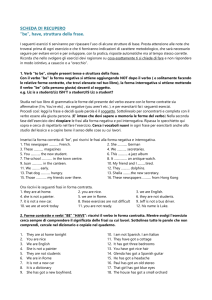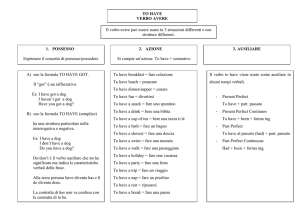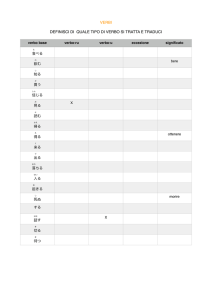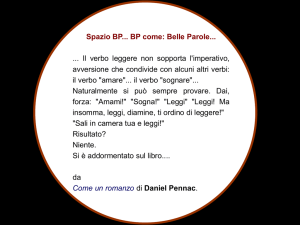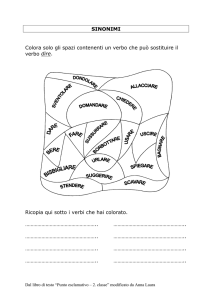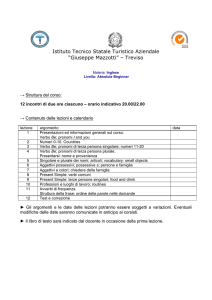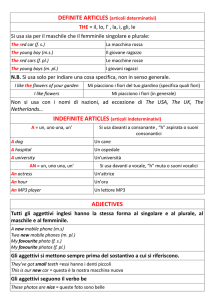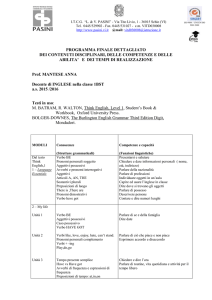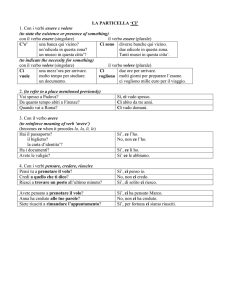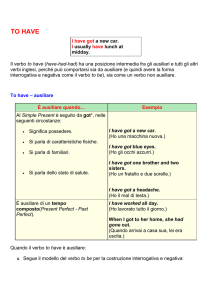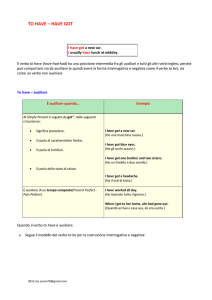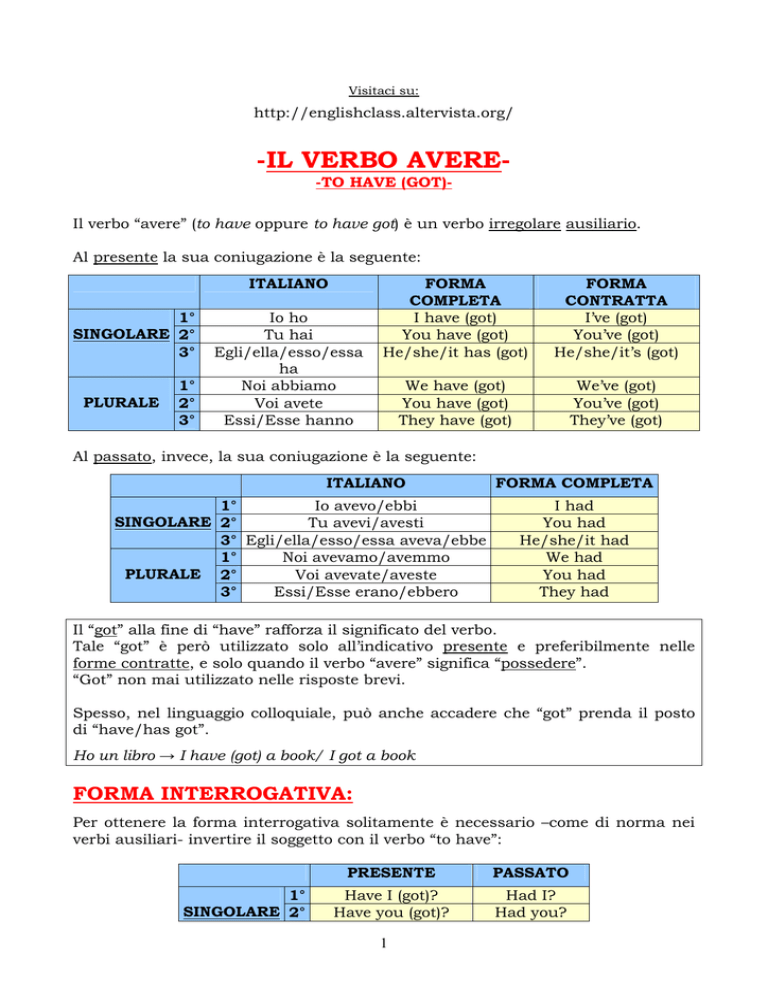
Visitaci su:
http://englishclass.altervista.org/
-IL VERBO AVERE-TO HAVE (GOT)Il verbo “avere” (to have oppure to have got) è un verbo irregolare ausiliario.
Al presente la sua coniugazione è la seguente:
ITALIANO
1°
SINGOLARE 2°
3°
PLURALE
1°
2°
3°
Io ho
Tu hai
Egli/ella/esso/essa
ha
Noi abbiamo
Voi avete
Essi/Esse hanno
FORMA
COMPLETA
I have (got)
You have (got)
He/she/it has (got)
FORMA
CONTRATTA
I’ve (got)
You’ve (got)
He/she/it’s (got)
We have (got)
You have (got)
They have (got)
We’ve (got)
You’ve (got)
They’ve (got)
Al passato, invece, la sua coniugazione è la seguente:
ITALIANO
1°
Io avevo/ebbi
SINGOLARE 2°
Tu avevi/avesti
3° Egli/ella/esso/essa aveva/ebbe
1°
Noi avevamo/avemmo
PLURALE 2°
Voi avevate/aveste
3°
Essi/Esse erano/ebbero
FORMA COMPLETA
I had
You had
He/she/it had
We had
You had
They had
Il “got” alla fine di “have” rafforza il significato del verbo.
Tale “got” è però utilizzato solo all’indicativo presente e preferibilmente nelle
forme contratte, e solo quando il verbo “avere” significa “possedere”.
“Got” non mai utilizzato nelle risposte brevi.
Spesso, nel linguaggio colloquiale, può anche accadere che “got” prenda il posto
di “have/has got”.
Ho un libro → I have (got) a book/ I got a book
FORMA INTERROGATIVA:
Per ottenere la forma interrogativa solitamente è necessario –come di norma nei
verbi ausiliari- invertire il soggetto con il verbo “to have”:
1°
SINGOLARE 2°
PRESENTE
PASSATO
Have I (got)?
Have you (got)?
Had I?
Had you?
1
PLURALE
3° Has he/she/it (got)? Had he/she/?
1°
Have we (got)?
Had we?
2°
Have you (got)?
Had you?
3°
Have they?
Had they?
Tuttavia, specie nell’inglese americano, è possibile considerare il verbo “to have”
come un qualsiasi verbo, e ottenere quindi la forma interrogativa aggiungendo un
do/does (presente) o un did (passato) prima del soggetto, come nei verbi non
ausiliari. In quel caso non si utilizza “got” alla fine del verbo.
PRESENTE
PASSATO
1°
Do I have?
Did I have?
SINGOLARE 2°
Do you have?
Did you have?
3° Does he/she/it have? Did he/she/it have?
1°
Do we have?
Did we have?
PLURALE 2°
Do you have?
Did you have?
3°
Do they have?
Did they have?
FORMA NEGATIVA:
Per ottenere la forma negativa solitamente è necessario –come di norma nei verbi
ausiliari- inserire l’avverbio negativo “not” dopo verbo “to have”:
PRESENTE
FORMA NON CONTRATTA FORMA CONTRATTA
1°
SINGOLARE 2°
3°
1°
PLURALE 2°
3°
I have not
You have not
He/she/it has not
We have not
You have not
They have not
I haven’t (got)
You haven’t (got)
He/she/it hasn’t (got)
We haven’t (got)
You haven’t (got)
They haven’t (got)
PASSATO
FORMA NON CONTRATTA FORMA CONTRATTA
1°
SINGOLARE 2°
3°
1°
PLURALE 2°
3°
I had not
You had not
He/she/it had not
We had not
You had not
They had not
I hadn’t
You hadn’t
He/she/it hadn’t
We hadn’t
You hadn’t
They hadn’t
Tuttavia, specie nell’inglese americano, è possibile considerare il verbo “to have”
come un qualsiasi verbo non ausiliare, e ottenere quindi al forma negativa
aggiungendo un do not/does not (presente) oppure un did not (passato) dopo il
soggetto. In quel caso non si utilizza “got” alla fine del verbo.
2
PRESENTE
FORMA NON CONTRATTA FORMA CONTRATTA
1°
SINGOLARE 2°
3°
1°
PLURALE 2°
3°
I do not have
You do not have
He/she/it does not have
We do not have
You do not have
They do not have
I don’t have
You don’t have
He/she/it doesn’t have
We don’t have
You don’t have
They don’t have
PASSATO
FORMA NON CONTRATTA FORMA CONTRATTA
1°
SINGOLARE 2°
3°
1°
PLURALE 2°
3°
I did not have
You did not have
He/she/it did not have
We did not have
You did not have
They did not have
I didn’t have
You didn’t have
He/she/it didn’t have
We didn’t have
You didn’t have
They didn’t have
FORMA INTERROGATIVA-NEGATIVA:
Per ottenere la forma interrogativa-negativa (che si tralascia di riportare) è
dunque necessario:
1) invertire il soggetto con il verbo sia inserire l’avverbio negativo “not”, oppure…
2) inserire un do not/does not (presente) o un did not (passato) prima del
soggetto. Di preferenza si utilizzano però le forme contratte don’t/doesn’t o un
didn’t.
FORME CONTRATTE:
Come detto anche per il verbo essere, le forme contratte sono utilizzate nel
linguaggio parlato e nello scritto informale, in quanto più veloci.
Le forme contratte affermative non si usano mai, però, al termine di una frase.
Nelle frasi interrogative negative è invece utilizzata quasi esclusivamente la forma
contratta.
P.S.
Esiste anche una particolare forma di contrazione utilizzata solo nel linguaggio
gergale e molto comunemente nelle canzoni. Normalmente viene considerata una
forma un po’ rozza, da evitarsi in un linguaggio più elegante.
Si tratta di “Ain’t”.
“Ain’t” sta per “haven’t” e “hasn’t”, ed è utilizzato sia nelle frasi negative che nelle
interrogative negative.
3
PARADIGMA:
Il paradigma di un verbo è costituito da:
Infinito – past tense – past participle
Il paradigma del verbo “to be” è dunque:
to have – had - had
Anche il verbo “to have” può avere una “forma progressiva”:
I’m having much fun→ mi sto divertendo/mi diverto molto
FRASI PARTICOLARI:
Il verbo “to have” significa in generale “avere”, e il suo utilizzo all’interno di una
frase è in generale identico all’italiano.
Ci sono però anche molte espressioni idiomatiche inglesi che utilizzano questo
verbo. In esse il verbo “to have” assume il significato di “prendere” o “fare”.
To have breakfast/lunch/a snack/dinner (o supper) → fare colazione, pranzare,
fare merenda, cenare
To have a break → fare una pausa
To have coffee/tea/a drink/a piece of cake → prendere un caffè, prendere un thè,
prendere un drink (bere qualcosa), prendere una fetta di torta
To have a good day → Avere/passare una bella giornata
To have a talk (a chat) → chiacchierare, fare una chiacchierata
To have a walk → fare una passeggiata, camminare, fare una camminata
To have a run/a swim → fare una corsa, fare una nuotata
To have a ride → fare una cavalcata
To have a rest → riposarsi, fare un riposino
To have a bath/shower → fare il bagno, fare la doccia
To have an argument/a fight → discutere (avere una discussione), litigare (avere
una lite)
To have a look → guardare, dare un’occhiata
…E molte altre.
In questi casi il verbo “to have” non è mai seguito dal “got”, e nelle frasi
interrogative o negative richiede l’uso del “do/does”/ “do not/does not” come i
verbi non ausiliari.
4
All’imperativo, il verbo “to have” è poi utilizzato come augurio o come invito.
ESEMPIO: Have a merry Christmas!
Have a seat!
“TO HAVE” COME VERBO SERVILE:
I verbi servili sono verbi ausiliari.
Il verbo “avere” è usato come verbo servile quando, composto con un altro verbo
(solitamente al participio passato), aiuta a costruire una forma verbale.
In quel caso il verbo servile è “have” non “have got”.
Visitaci su:
http://englishclass.altervista.org/
5

